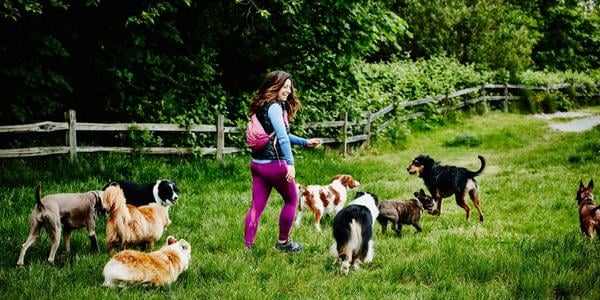
If you're thinking about when you can take your dog to the park, you should also consider"if" you should take them to an off-leash dog park. Dog parks can provide exercise and social interactions for dogs, but also present some risks both to your dog's health and to their behavior.
It's crucial to make sure that your dog has all the necessary "core" vaccinations and talk to your veterinarian about others that could be worthwhile for your environment.
Beyond being physically ready, an often overlooked part of going to dog parks is whether a dog is behaviorally ready and will enjoy the dog park. Dog parks can be busy and overwhelming for many dogs. Knowing whether your dog is mature enough is important to prevent potentially lifelong behavior issues.
Let's dive into when you can take your dog to the dog park, whether dog parks are good or bad, what vaccines your dog needs beforehand, and how to make sure everyone stays safe and has fun!
Table of Contents
How Old Does a Dog Need to Be to Go to the Dog Park?
When Can Puppies Go to the Dog Park?
From a veterinarian's point of view, a puppy should not be brought to a dog park until they are a minimum of 17 weeks old to allow for the full protection of their puppy vaccinations. Puppies typically finish their vaccinations at 16 weeks old but need another week for the vaccines to reach full efficacy in their system. Read all about needed puppy vaccines, including the typical timing of these shots, and discuss your dog's specific vaccination needs with your vet.
The core vaccinatable dog diseases include Parvo, distemper, adenovirus, and rabies. We highly recommend talking to your veterinarian about making sure your dog has the Bordetella vaccine before visiting dog parks or daycare as puppies are more susceptible to complications from this illness.
At a minimum, ALL dogs should be fully vaccinated against these diseases before going to a dog park. There are plenty of other illnesses and problems dogs can encounter at the dog park (you can see a list further below).
Why Dog Trainers Don't Like Dog Parks for Puppies
Dog parks sound like they are the answer for providing your dog with needed socialization, exercise, and play. But you may be surprised to learn that most certified dog trainers and veterinarians are not fans of dog parks. From the behavioral viewpoint, professional trainers and behavior consultants tend to recommend avoiding dog parks because of the unintended consequences of uncontrolled or overwhelming experiences.
The dog park is not a good place to take a young puppy to socialize with other dogs. Because the dog park is not supervised by a professional educated in dog body language and allows any and all dogs to attend, there are often interactions between dogs that cause lifelong fear, anxiety, and even aggression. For this reason, it's recommended to wait until your puppy is at least 6 to 8 months old before going to the dog park.
Avoid taking your puppy to the dog park until they are at least 6 to 8 months old. This allows for time to learn appropriate social and play behaviors in supervised puppy classes and helps you understand your dog's tolerance levels for dog park environments.
Dog parks are not meant for initial socialization for puppies. Things learned in early life have a lifelong effect, especially during your puppy's critical socialization period (between the ages of 7 weeks to 16 weeks). But their social learning doesn't just stop at the end of this socialization period. Your dog's brain is developing until they are around 2 years old. The risk of a negative experience at the dog park outweighs any potential benefit of getting to run around off-leash and play. Learn how to socialize your puppy the right way here.
Because of the risks dog parks present to training and behavior, I don't actually recommend dog parks for any dog. But if you want to take your dog to one, waiting until they are at least six months old allows enough time to socialize safely and properly at puppy class or during planned one-on-one play dates with other dogs. This also gives you a chance to learn your puppy's play style and personality and consider whether they will do well at a dog park. They may be too sensitive, or they may be too pushy. Your puppy's dog trainer can help you determine what the right decision is for you.
Try our free Pupstanding App to get your puppy started with socialization to sights, sounds, and so much more.
Should Senior Dogs Go to the Dog Park?
Keeping aging dogs moving is a big part of maintaining their mobility and health. But you do want to consider a few things if you want to bring your senior dog to the dog park. Does their size and mobility place them at increased risk of accidental injury from other dogs? This could be simply being bumped into, rolled, or run over. If your dog is arthritic, has possible hip dysplasia or spinal arthritis, or is a long-backed dog, one bump during play could dislocate the hip or herniate a disc.
Senior dogs face higher risks of complications from illnesses that they may contract at the dog park. Consider whether you're comfortable with this increased risk based on your dog's particular health condition and ask your vet what they would recommend.
Are they as social as they were when they were younger? The majority of dogs "age out" of group play simply because they become more dog-selective as they age – just like people! Does your dog show signs of pain or soreness the day or two after a visit to the dog park? That can mean that shorter dog park visits are in order.
If your dog is slowing down with age but still enjoys the dog park environment, go to the dog park during off-peak hours or when there are fewer dogs in attendance. If the dogs at the park are rambunctious and have a rougher style of play, then leave and return later when it's calmer.
Disease Risks at the Dog Park
Unfortunately, there is a high risk that your dog will get sick at the dog park. The good news is that most illnesses are relatively mild — most, but not all. Your dog’s risk will be determined by their vaccination status, your (and other people's) use of parasite preventatives — fleas, heartworms, intestinal worms, and ticks — the time of year, cleanliness of the dog park (people’s adherence to picking up their dog’s poop), how crowded the park is, and a variety of other factors.
You should be aware of and take precautions to prevent the following transmittable diseases:
Leptospirosis
Lepto is a nasty bacterial infection that attacks and can shut down a dog’s kidneys and/or liver. It’s spread through contact with water contaminated by either rodent urine or the urine of an infected dog. There is a vaccine against “Lepto.” The condition is also zoonotic, meaning that people can catch it from infected dogs. Learn more about the risk of Lepto and puddles.
Giardia Infection
A protozoal infection that can cause diarrhea of varying severity. Some strains can also infect and sicken people. There is no effective vaccine against Giardia. It is most prevalent during wet times of the year. Dogs get Giardia when they drink water — from a puddle, pond, or even a communal dog bowl — that is contaminated with the organism. Do not allow your dog to drink water from a shared water bowl at the dog park. Bring your own water and a portable water bowl.
Intestinal Parasites (hookworm, roundworm, whipworm)
Microscopic intestinal parasitic worms that are caught primarily when a dog ingests the infective larval stage of the worm or infective eggs while eating dirt and mud. Routine dewormers given in the series of puppy veterinary visits and many heartworm preventatives are effective at preventing and treating intestinal parasites.
Kennel Cough (Infectious Tracheobronchitis)
A complex airborne syndrome that results from a variety of causative organisms, both viral and bacterial. Most cases of kennel cough are usually mild and resolve on their own, but some can progress to the lower airways, causing pneumonia. There are vaccines available for kennel cough (especially for the most common bacteria, Bordetella bronchiseptica), which help prevent infection or reduce the severity of infection.
Dog Flu (Canine Influenza Virus, CIV)
Unfortunately, as with the human flu viruses, the CIV strains are highly contagious. Dog flu is more of a problem in certain parts of the country than others, so not all dogs are at the same risk of infection. Check with your veterinarian to see if (and when) dog flu is a problem in your area or if you travel with your dog frequently. There are vaccines for the two known CIV strains.
Parvo (Parvoviral enteritis)
Parvo is everywhere, and it’s debilitating and deadly! The Parvovirus is highly contagious in dogs and can persist in the environment for months after an infected dog has been there. Fortunately, there is a very effective vaccine against Parvo. Parvo is horrific, and preventing outbreaks depends on everyone having their puppies and adult dogs properly and effectively vaccinated and keeping sick dogs out of multi-dog environments (like dog parks).
Distemper
A highly contagious viral condition that, thanks to vaccination, is seen far less throughout the U.S. than in years past — though there are still occasional small outbreaks. It’s spread primarily when an infected dog coughs or sneezes on or around an unprotected dog. There’s no known cure for distemper, but fortunately, there are highly effective vaccines.
Fleas
These pesky blood-sucking parasites are everywhere and, contrary to what you may have heard, are a year-round risk. Learn more about fleas and what they can do to your dog (and you). Dog parks are, unfortunately, great breeding grounds for fleas, even when there are no dogs in sight! Make sure your pup is safely and effectively protected against fleas before venturing into the dog park.

Are Dog Parks Good or Bad for Dogs?
While dog parks can provide exercise and social interaction for SOME dogs and even their owners, many dogs don't enjoy or do well in a dog park environment. Depending on the type of dog and the type of person, the dog park experience can vary wildly. Some dogs take to the new environment with ease, while others take longer to adjust. And some just aren’t going to do well in the dog park at all — not now or ever.
The majority opinion within the dog trainer community is that dog parks are not a good choice for most dogs. We have seen the behavioral consequences of dog park attendance. I often see social media posts in my local area about the many dog fights or dog attacks that occur at dog parks. Because of the high risks and unpredictability of dog parks, I don't recommend them. It is not "normal" to expect a dog to get along with any and every dog they encounter, yet that is what we are doing when we go to the dog park.
Should you take your dog to the dog park? I know that for many dog owners, dog parks are appealing because they are a rare opportunity in an urban area to provide off-leash time. If this is the case for you, then your dog needs to be friendly, healthy, and already socialized with other dogs and people. If your dog has ever shown fear, aggression, social anxiety, resource guarding, or otherwise has shown they do not enjoy group dog play, it's best to avoid the dog park.
If you're debating whether to grab your pup and head to the dog park, it's crucial you know "best practices" to keep them safe, both health-wise and behavior-wise. A lot can go wrong at dog parks, so it's best to be prepared.
How to Prepare for the Dog Park
- Know how to break up a dog fight. Scuffles and altercations between unfamiliar dogs happen primarily at dog parks. Play itself is a highly arousing activity, and there can easily be a misunderstanding between dogs as far as how hard they can bite and whether or not they are enjoying themselves or not. And just like one person doesn't get along with every other person, there are simply times when a dog just doesn't like another dog. Without good communication skills and de-escalation practice (something puppies and adolescent dogs lack), moments of disagreement can quickly turn into a dog fight.
Review these steps for breaking up a dog fight safely.
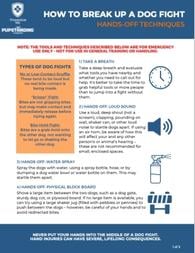 Download a printable flyer of the steps for breaking up a dog fight. Share this infographic or post it in your facility! Simply fill out this form for instant download access.
Download a printable flyer of the steps for breaking up a dog fight. Share this infographic or post it in your facility! Simply fill out this form for instant download access. - Solidify your dog’s basic training. Certain skills and behaviors should be bulletproof before taking any dog to a dog park. It’s most important to make sure your dog is solid on name recognition, recall, and leave it before you head to the dog park.
- Scout the park. Before taking your dog to a dog park, walk by it a few times over a few days to scout it out. Take note of potential “trouble spots” and see how the dogs (and people) in the park interact. Is the fencing secure? Is the entry/exit gate crowded or clear? Are people picking up their dog's poo, and does the park appear clean? Are the grounds clear of any "potholes" or divots that could cause injury?
- Know your dog's play style and preferences. If your dog is a dainty or sensitive player and you notice lots of rough-and-tumble dogs in the park, that's a sign to postpone your visit before even entering or to leave if you're already inside. And vice versa! You don't want your dog to become a target or be the one to target others. Being a rough player doesn't make your dog "bad," but it does mean that you need to carefully manage who they interact with so they don't inadvertently traumatize other dogs.
- Size Matters: Avoid bringing smaller dogs to parks frequented by larger dogs. The serious (and sometimes fatal) injuries resulting from larger dogs attacking smaller dogs are common enough that we have an acronym: BDLD, short for “Big Dog Little Dog.” And it's not just attacks – a small dog can be injured simply by being stepped on or rolled over by a larger dog during play. Fortunately, more and more dog parks now provide separate “big dog” and “little dog” areas.
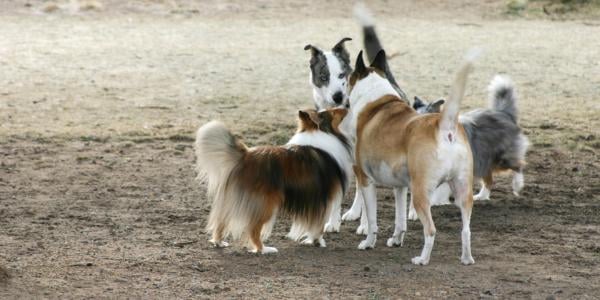
Keeping your dog on leash around other dogs who are off-leash puts your dog at a disadvantage. Avoid having your dog on leash inside the dog park.
Keep Your Dog Safe at the Dog Park
- Exercise First. I know this sounds counterintuitive. You're taking your dog to the dog park to get some exercise in, right? Well, if you have a high-energy dog, it's best to take the edge off a bit with a short game of tug, flirt pole, or a warm-up walk before going off-leash in the dog park.
Dog parks are inherently exciting for dogs with all the smells, sights, sounds, and interactions. The more aroused their nervous system, the less their brain works. This can mean they lack inhibition, which can lead to miscommunication and worse. Exercising first helps to diffuse excess energy and lower arousal. - Watch the Dog Park First, Before Entering: Any time you visit the dog park, even if you've had only pleasant experiences in the past, always watch to see what dogs and people are there before entering with your dog. Does someone seem to be ignoring their dog, who is pestering other dogs? Is the vibe just not the right fit for your dog's playstyle? Is the park too crowded or chaotic? If you see anything that gives you pause or just doesn't feel right, leave and come back another day.
- Pay Attention: Don’t let yourself zone out, and certainly don’t leave your dog in the dog park unsupervised. You should always keep an eye on your dog to make sure they and the other dogs are all playing nicely together. The dog park is not the time to be texting or talking on your phone.
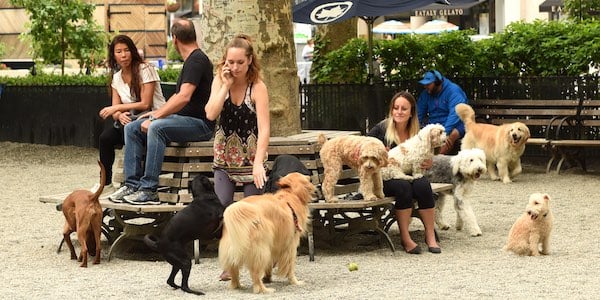
- Read Body Language: Dogs are very communicative. They tell each other how they are feeling and their intent with their body language, movement, and facial expressions. Their behaviors and body positions tell an in-depth story if you know how to read it. Visit our Dog Body Language Resource Page for loads of resources on learning to "speak dog."
Play between dogs can seem overwhelming, considering it tends to involve lots of teeth. Beyond learning basic dog body language, spend extra time learning how to manage dog play. It takes practice to get comfortable managing playing dogs. - Never Bring Toys, Treats, or Food into the Dog Park: Don’t bring toys or treats into the dog park. Even if your dog isn’t food-aggressive or possessive of their toys, other dogs at the park might be. Instead, leave the toys and treats at home. I have never understood people who take their dog's balls to the dog park and then get angry at other dogs for "stealing" their dog's toy. That's typical and expected dog behavior.
The same goes for any human food. I have unfortunately seen people bring their snacks or sandwiches with them into the dog park and then get mobbed by the dogs interested in snagging a piece. This is a recipe for a dog fight since human food can be a high-value resource. - Don't Put Your Dog On Leash in Off-Leash Areas: Having your dog on leash around other dogs who are off-leash puts your dog at a disadvantage. They aren't able to move freely or add distance if they want. Many dogs who are on leash are much more likely to react defensively sooner than if they were off-leash, simply because we have removed their option to move away. To prevent this from happening, when inside an off-leash area, keep your dog off-leash. Put them on their leash in the "airlock" portion of the dog park entrance or right at the entrance before exiting if there is no double-gated safety entrance.
- Keep Moving: When in the dog park, always stay in motion. Never stand still! Your movement will help dogs keep moving as well, which reduces tension and helps prevent scuffles. If you stand still, your dog may hover by you, and other dogs may congregate around you both. This can cause a fight because a dog may feel the need to guard you or simply can't find an easy way out.
Moving also means it's less likely you'll get knocked down by playing dogs. I have heard many stories from dog owners about how they or someone they know has gotten injured or their knees blown out by dogs running into them. Keep moving, and keep your knees bent! - Leave, If Necessary: If there’s a problem with one or more dogs, and their owners won’t leave, then you should leave yourself. It’s not worth a confrontation and not worth hoping the other dog(s) will stop harassing your dog — they probably won’t. Just leave and find another way to exercise and socialize your dog. It’s far safer for everyone.
- No Children in the Dog Park: A dog park is not a safe place for young children. It doesn't matter if your child does well with your dog at home. The other dogs who may be at the dog park may be frightened of or aggressive toward children. It's not fair to other dogs to make what may be their only option for off-leash outdoor time a negative experience by bringing your children into the dog park. Bringing children to the dog park is incredibly unsafe. Beyond the risk of being bitten by a dog, exuberant dogs may accidentally injure a child by knocking them over or jumping on them.
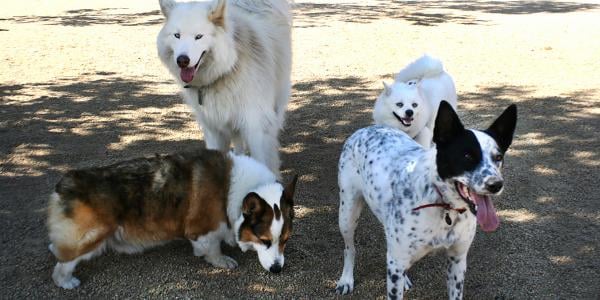
What If the Dog Park Isn’t a Good Option for Your Dog?
Don’t worry if the dog park just isn’t a good fit for you or your dog. There are many other ways to get your pup the exercise and socialization they need.
- Organized one-on-one or small group playdates at your home or a friend's home.
- Rent a Sniffspot.
- Hikes, romps on the beach, and long walks around town.
- Dog daycare.
- Sniffari walks.
- Dog sports like agility, nose work, herding, dock diving, and flyball.
- A responsible dog walker: More and more dog trainers are offering this type of service. You might even be able to arrange to share responsibilities with local dog-owning friends, neighbors, and relatives.
- Increase mental enrichment. Working your dog's brain helps to burn excess energy.
- Take your dog to work.
What are your thoughts on dog parks? Yay or nay for your dog? Let us know in the comments!




